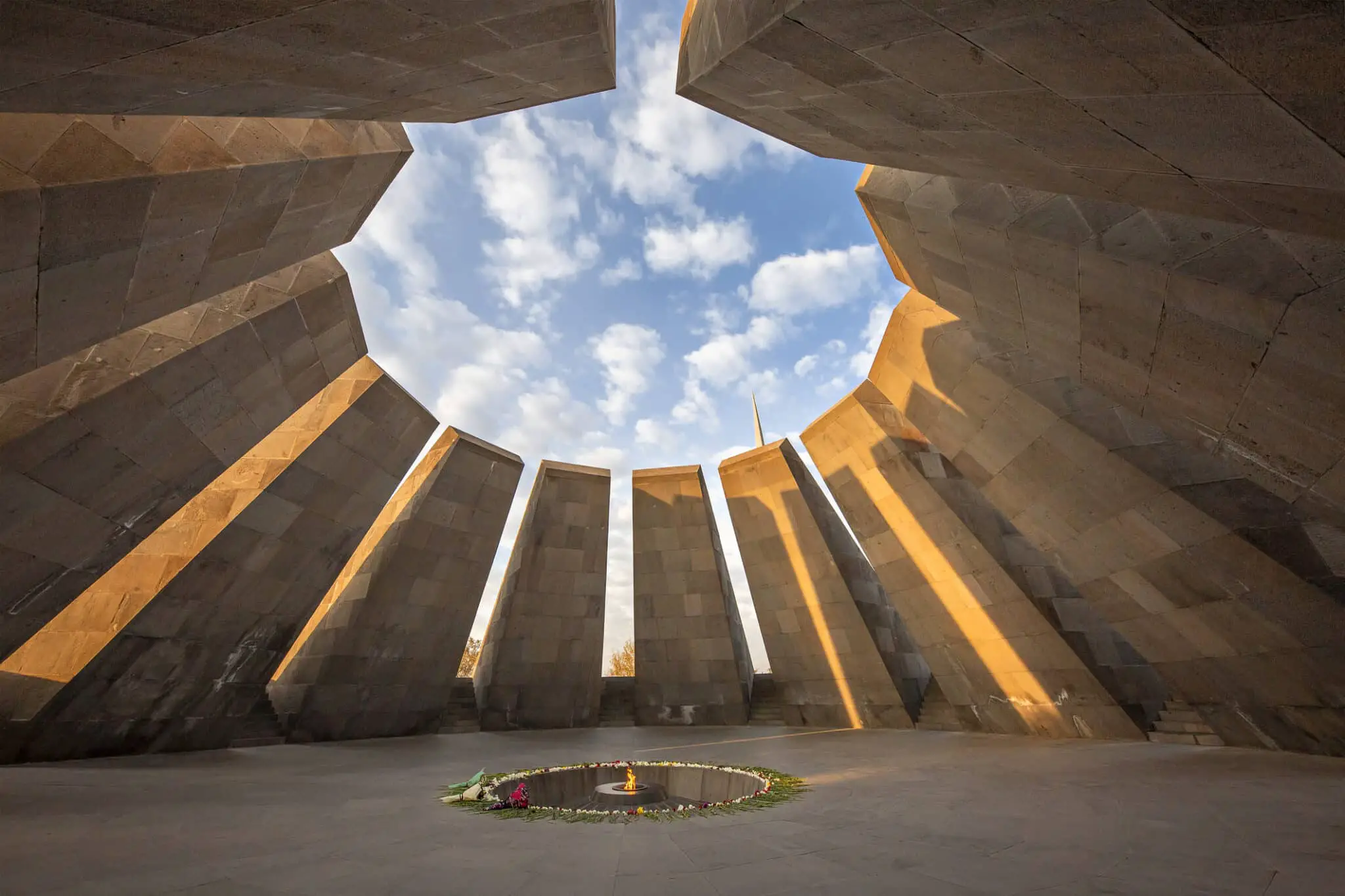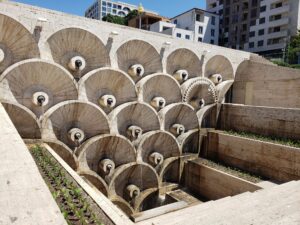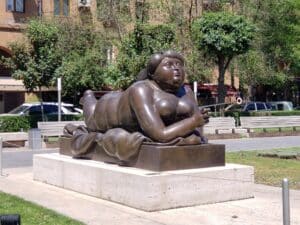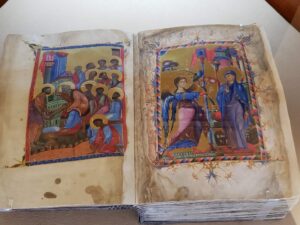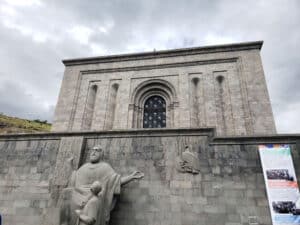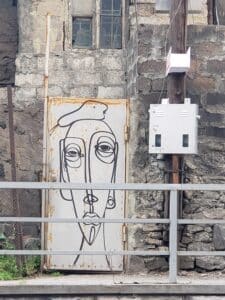The following is a brief introduction to some of the best Yerevan museums for history and art. As SRAS has recently launched study programming in Armenia, MuseumStudiesAbroad.org is also now opening a new region that we hope to fill with museum reviews and artist biographies!
History Museum of Armenia
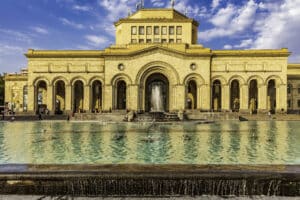
The History Museum of Armenia holds a collection of over 400,000 artifacts, ranging from prehistoric times to the modern era. The exhibits are organized chronologically, with each section showcasing the major events and developments in Armenian history, such as the emergence of early civilizations, the adoption of Christianity, and the struggles for independence and statehood.
Exhibits include a wide variety of artifacts, such as ancient tools and weapons, medieval manuscripts, traditional clothing and textiles, and works of art. You’ll also see coins traded from ancient Greek, Roman, Arab, and Seljuk lands, and artifacts depicting Armenia’s early connections with Christian and Hellenistic cultures.
The museum was founded in 1919, making it one of the oldest museums in Armenia.
The History Museum of Armenia offers affordable guided tours in English and student discounts on entrance tickets. See the website for details.
Armenian Genocide Museum-Institute
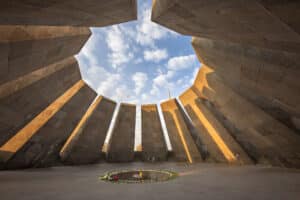
The Armenian Genocide Museum-Institute was opened on April 24, 1995. That date coincided with the 80th anniversary of the start of the Armenian Genocide, which took the lives of about 1.5 million Armenians under the Ottoman Empire.
The museum is a three-story building, most of which is taken up by 12 great halls that cover the history of the event from its historical background to its memorialization and aftermath. These halls feature exhibits and multimedia displays of photos, documentary video, as well as personal stories and artifacts. The entire third floor is taken up by the research center, which holds a vast collection of documents, photographs, and other materials.
Descriptions of the materials are available in multiple languages, including English. English-language tours are also available. See the website for details. There is also a bookstore and a cafe onsite.
Outside the museum is a large outdoor installation called the Memorial Wall, which consists of carved basalt slabs inscribed with the names of towns and villages where Armenians were massacred, as well as the names of prominent Armenian figures who were killed during the genocide. In front are several bronze statues that represent the Armenian experience of those horrible events. The wall serves as a powerful place of reflection and remembrance for the victims of the genocide.
Cafesjian Center of the Arts
and the Cascades Complex
The Cafesjian Center of the Arts is housed in the Cascades Complex, a monumental staircase in downtown Yerevan that features numerous fountains, sculptures, and gardens. If you can conquer all 572 steps, you’ll be rewarded with an unobstructed view of Yerevan’s skyline and Mt. Ararat.
Inside these massive stone steps lies the Cafesjian Center of the Arts, which includes over 5,000 works of art, ranging from paintings and sculptures to installations and multimedia artworks, created mostly by artists from Armenia.
Founded in 2009, it is named after its founder, Gerard Cafesjian, an Armenian-American businessman and philanthropist. Admission is free of charge.
The museum shows a range of styles and genres, from traditional to contemporary, and includes works by both established and emerging artists. Some of the museum’s most notable exhibits include the Glass Gallery, which features a collection of glass sculptures, and the Sculpture Garden, which showcases a variety of outdoor sculptures.
In addition to its exhibits, the Cafesjian Center of the Arts also hosts a range of educational and cultural programs, including lectures, workshops, and concerts. The museum’s mission is to promote contemporary art and culture in Armenia, and to provide a platform for artists and scholars to engage with the wider public.
Yerevan History Museum
The Yerevan History Museum is dedicated specifically to the history and culture of the city. Founded in 1931, it was moved to its current location in 2005, a newly-constructed monumental building that looks as though it were carved directly from a single piece of local stone.
The museum holds over 100,000 artifacts, ranging from archaeological finds to photographs, documents, and other historical materials. The exhibits are organized thematically, with each section tracing a new stage of the city’s development, from its ancient origins to its modern development as the capital of Armenia.
On display are archeological finds from pre-Christian times, artifacts from the area’s medieval Christian culture, and momentos of the great merchant families that helped build the city’s management, trade, and industry. See the fine arts collection from artists that lived and worked in the city and artifacts that showcase Yerevan’s great publishing industry, which has been particularly important to Armenian-language literature to the world’s widespread Armenian diaspora.
The Yerevan History Museum is an important cultural institution in Armenia, serving as a repository for the city’s rich history and heritage.
Erebuni Fortress and Museum
The Erebuni Museum is located at the foot of the hill where a great fortress built in the 8th century BCE by the Urartian King Argishti I still stands in ruins. The fortress was the centerpiece of a great ancient city called Erebuni. The museum was founded in 1968 and is housed in a modern building designed to resemble an Urartian fortress.
The relationship between the Urartians and the Armenians is a subject of ongoing debate among historians and scholars. While the Urartians and Armenians lived in the same region and shared some cultural and linguistic similarities, it is not entirely clear whether there is a direct genetic or cultural link between the two groups.
Nevertheless, Erebuni is often pointed to as proof of the ancient importance of Yerevan and the area’s long history with advanced civilizations. The ruins of the fortress are walkable, and is worthwhile even though there are few signs to tell you what you are looking at.
The museum at the base of mountain from the fortress offers exhibits showcasing the Urartian civilization, which flourished in the region from the 9th to the 6th centuries BCE. These exhibits include pottery, jewelry, weapons, and tools, as well as a replica of the famous “Erebuni Inscription,” which is the oldest known Armenian writing. The exhibits are organized thematically, highlighting the major aspects of Urartian religion, art, and technology.
In addition to its exhibits, the Erebuni Museum also features a multimedia hall, where visitors can watch a documentary about the history and culture of the Urartian civilization. The museum also offers guided tours and educational programs for visitors of all ages.
Matenadaran Armenian Manuscript Museum
The Matenadaran is a museum and research institute located in Yerevan, Armenia, dedicated to the preservation and study of ancient manuscripts and documents. Armenia is particularly proud of its language and its unique alphabet, which have helped hold together Armenian culture despite the fact that its population has been historically spread across the globe and ruled by a myriad of states and empires.
The museum was founded in 1920 and is housed in a modern building that was opened in 1959. Designed by the renowned Armenian architect Mark Grigoryan, the building is simple yet bold, looking perhaps more like a temple than a museum. It built from the same abundant local rock that defines much of Yerevan’s architecture and is decorated with intricate carvings and bas-reliefs, including depictions of Armenian historical figures, cultural icons, and biblical scenes. Outside are several statues of major figures from Armenian culture and learning including Mesrop Mashtots, the sainted founder of the Armenian alphabet.
The museum’s collection includes over 23,000 manuscripts and maps dating back to the 5th century CE. The texts cover history, literature, religion, and science. religious works, poetry and literature, Greek and Syriac translations, math and music, alchemy and astrology, and more. In pride of place are three famous gospels from the 9th-11th centuries. The museum also offers a reading hall where you can explore for yourself digitized versions of the manuscripts and archives.
The Matenadaran is also a research institute, with a team of scholars dedicated to the study and preservation of the manuscripts in its collection. The Matenadaran also offers a range of educational and cultural programs, including lectures, workshops, and concerts.
Discounted entry tickets are offered to students and affordable guided tours in English are available.
Ararat Brandy Factory Museum
Armenia takes incredible pride in its ancient winemaking traditions as well as its renowned brandies and cognacs.

The Ararat Brandy Factory Museum was founded in 2002 and is housed in a historic building within the Ararat Brandy Factory complex. The factory itself was founded in 1887 by an Armenian merchant named Nerses Tairyan and has since become one of the most famous and respected brandy producers in the world.
The museum takes you on a tour of the history and culture of brandy in Armenia, as well as the production process and traditional and modern techniques used by the Ararat Brandy Factory. You’ll see a wide range of old barrels and bottles, vintage advertisements, and historical photographs and documents.
Definitely do not miss the brandy tasting room, where visitors can sample a variety of Armenian brandies, including the famous Ararat brand. The museum also offers guided tours of the factory, where visitors can see the production process firsthand, from the selection of grapes to the distillation and aging of the brandy.
The Ararat Brandy Factory Museum also hosts cultural and educational programs, including lectures, workshops, and concerts. Tours in English are available. See the website for details.
What is it like to visit? Read this review from SRAS student Charlie Bacsik.
Sergei Parajanov Museum
The Sergei Parajanov Museum is dedicated to the life and works of Sergei Parajanov, a renowned Soviet Armenian filmmaker and artist. The museum was established in the heart of Yerevan in 1988, shortly before Parajanov’s death.
Sergei Parajanov (1924-1990) was a renowned Armenian film director and artist known for using unconventional narrative structure and poetic visual language. He explored themes of history, culture, and identity, often drawing on Armenian, Georgian, and other regional folklore and traditions.
Throughout his career, Parajanov faced censorship and persecution by Soviet authorities, who disapproved of his artistic vision and his open homosexuality. He was arrested several times and spent several years in prison and in forced labor camps.
In addition to his films, he was also a prolific painter, collage artist, and installation artist, and his work has been exhibited in galleries and museums around the world.
The museum’s collection includes over 600 works by Parajanov, including films, photographs, collages, assemblages, and other multimedia artworks. You can also see rarer finds like unpublished screenplays he wrote as well as librettos, artworks, original film posters, festival prizes, and letters he exchanged with many of his contemporaries. They are arranged to showcase the major themes and motifs that run throughout Parajanov’s work, such as Armenian culture, folk art, and religious symbolism.
The result is a comprehensive and immersive look at Parajanov’s life and work, highlighting his unique artistic vision and his contributions to the world of cinema and visual art. The museum also features a screening room, where visitors can watch some of Parajanov’s most famous films, including The Color of Pomegranates and Shadows of Forgotten Ancestors.
The Sergey Parajanov Museum blends the filmmaker’s biography with his art and art inspired by him.
Komitas Museum-Institute
The Komitas Museum-Institute is a museum and research center located in Yerevan, Armenia, dedicated to the life and work of the Armenian composer and musicologist Komitas Vardapet. The museum was founded in 2015 and is housed in a modern building that was designed to reflect the aesthetics and spirit of Komitas’ music.
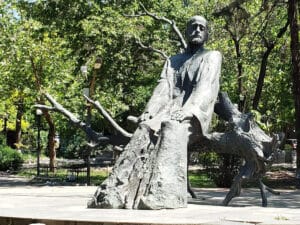
Komitas Vardapet (1869-1935) was an Armenian composer, ethnomusicologist, and priest. He spent much of his life collecting, recording, transcribing, and studying Armenian folk music, which he believed was an important part of Armenian cultural heritage. He also composed his own works, often based on traditional Armenian music, or as contributions to Armenian liturgical music. He also transcribed ancient Armenian chants and worked to preserve and promote the traditional Armenian liturgy. He was one of many Armenians arrested and tortured at the start of the Armenian Genocide. Although he was later released, he suffered so much trauma that he lived the rest of his days in a mental institution in France. He is remembered today as one of the most important thinkers in Armenian music history.
The museum highlights the major aspects of Komitas’ life and work, including his childhood, education, travels, and artistic achievements. It does this through his musical instruments, manuscripts, photographs, and personal items.
The Komitas Museum-Institute is also a research center, with a team of scholars dedicated to the study and preservation of Komitas’ legacy. The museum-institute also hosts a range of cultural and educational programs, including concerts, lectures, and workshops, aimed at promoting Armenian music and culture.
Museum of Russian Art
The Museum of Russian Art, Collection of A. Abrahamyan is a private museum located in Yerevan, Armenia, dedicated to the preservation and display of Russian art. The museum was founded by Armenian businessman and philanthropist Artur Abrahamyan, who is a prominent collector of Russian art.
The museum’s collection includes over 3,000 works of art, dating from the 18th to the 20th century, and representing a wide range of styles and genres, including painting, sculpture, and decorative arts. The collection includes works by many famous Russian artists, such as Ilya Repin, Ivan Aivazovsky, and Nicholas Roerich. Given the current difficulties in traveling to Russia with the current sanctions regime, those interested in Russian art may find the Museum of Russian Art an excellent resource in Yerevan.
In addition to painting, the museum also features sculptures, ceramics, and textiles. The facility also offers a range of educational and cultural programs, including lectures, workshops, and concerts.
The Wine History Museum
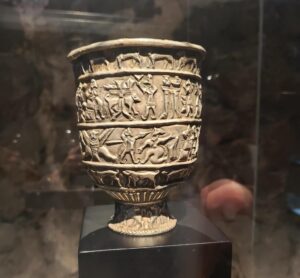
The Wine History Museum of Yerevan showcases Armenia’s ancient history of viticulture and winemaking through a collection of artifacts, manuscripts, and ethnographic studies. The museum’s main exhibition hall, located 8 meters underground in basalt rocks, presents the chronological stages of wine development in Armenia and its relationship with various aspects of Armenian culture.
The exhibits include agricultural and winemaking tools, leather wineskins, vessels, and jugs. The archaeological collection features exhibits from different eras, including black and red polished jars from the Early Bronze Age, ritual vessels from the Iron Age, and various cups and bowls. The museum also presents medieval manuscripts from the “Matenadaran” Research Institute of Ancient Manuscripts named after Mesrop Mashtots, including Gospels dating back to the 14th century and the first printed Bible in Armenian in 1666.
The museum aims to comprehensively research and present Armenia’s rich history of winemaking through interactive and innovative exhibits. Through the collection of artifacts, manuscripts, and ethnographic studies, visitors gain a deeper understanding of Armenia’s viticulture and winemaking traditions and its broader cultural history.


